Death on the Reik – the second part of the legendary Enemy Within campaign – has always been one of my very favourite WFRP adventures. A free-wheeling adventure along the stretch of the Reik between Altdorf and just north of Nuln, it gives players an unprecedented amount of freedom as well as providing a wide variety of situations for them to participate in – culminating in a highly impressive assault on a castle that is equal parts epic and horrifying. Throughout, the adventure is supported by a great variety of encounters – most memorably the confusing warnings from the cult of the Purple Hand.
The original adventure was written by Jim Bambra and Phil Gallagher, with accompanying material (‘The River Life of the Empire’) by Graeme Davis1. This “Director’s Cut” version was reworked by Graeme Davis, and incorporates some material from Carrion up the Reik by James Wallis (written as a bridging adventure between Death on the Reik and Power Behind the Throne, for the reprinted 1st edition).
As with my review of Enemy in Shadows (the first part of the campaign), this review does double duty as both of review of the new 4th Edition version of the adventure, as well as a note on the changes since the original version. Huge spoilers follow!
A few general notes on the book to begin with:
- There are LOTS of references to the Companion in this adventure, making it feel like an all but essential purchase
- The introduction includes an explanation that the River Life of the Empire (a 16-page pamphlet included with the original adventure) has been moved to the Companion rather than being part of the adventure as originally promised (a sore point for fans at time of publication). This callout box says “there’s still stuff of lasting value in this book” but I’m unconvinced – there is nothing approaching the value of the guide to Bogenhafen in EiS, and I feel that once you’ve played Death on the Reik, there’s not a lot of further value to be gleaned from this book.
- There are lots of lovely maps! These range from individual buildings, to settlements, to the Glorious Reikland itself (a reprint of the map in the main rulebook). For most maps, as well as the keyed versions within the text, there are unkeyed versions at the back to show to players.
- There are tons of grognard boxes offering potential changes for the adventure for returning players.
- Over the course of the adventure several potential replacement PCs are offered, which is nice (a Human Pedlar; a Dwarf Prospector and even a Halfling cook)
The structure of Death on the Reik is one of my favourites. It starts off by providing PCs with training opportunities (a crucial part of WFRP, noticeably lacking in any of the later Enemy Within adventures) and providing them with their very own boat. This has always been an inspired choice: it gives the players a genuine sense of increasing in power (going from being itinerant wanderers to having their own form of transport as well as a base of operations). But it also means that the PCs are effectively constrained to waterways – they can’t go wandering off to Middenheim, for instance, since there’s no river that way.
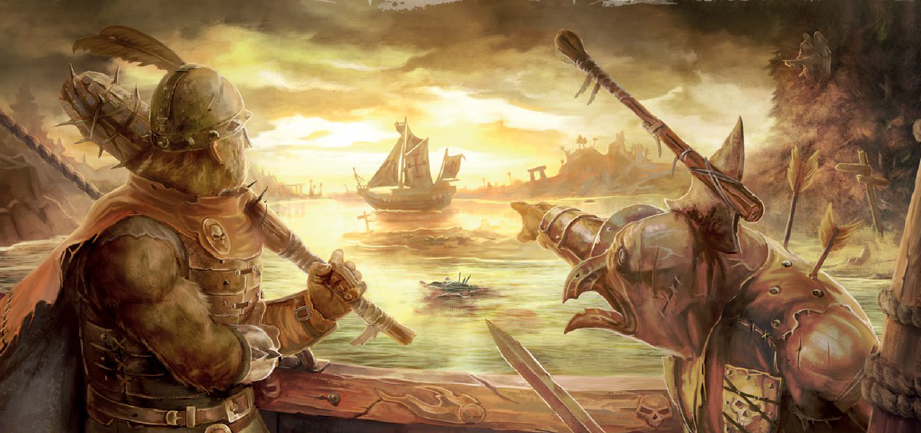
The first section of the adventure sees the PCs obtain their boat (its original owners massacred by a band of memorable mutants) before they retrace their steps along the Weissbruck Canal to Altdorf – with a brief but decent kidnap plot along the way. In the original version they then went north to Delberz in order for pregenerated PC Wanda (a wizard’s apprentice) to visit her mentor Heironymous Blitzen. This enabled the adventure to explicitly set them on the trail of Etelka Herzen, cultist of the Red Crown cult. The pregens are no longer a core part of The Enemy Within (they are in the Enemy in Shadows Companion though), so this sidetrack is no longer a part of the core adventure either; Heironymous is relegated to an appendix as a potential mentor. This is fair enough. However it does mean that a fairly major plot hook has been lost.
The Enemy Within has always struggled with having solid hooks (just wait til we get to Power Behind the Throne). Death on the Reik then is left with a single hook: at the end of Enemy in Shadows, the PCs found a letter from Etelka Herzen, indicating she is a Chaos cultist. This points them to Grissenwald, a long way south of Altdorf. There’s a real risk that players might simply not find this convincing enough – particularly since no-one is promising them any reward for investigating – and I think the inclusion of an actual patron (in place of Heironymous Blitzen) would be sensible.
In any case, en route to Grissenwald, the PCs find a signal tower under construction beside the river. I love the concept of the signal towers – another instance of the Empire feeling like an early Renaissance setting. Very nicely the signal tower has been built on the ruins of an old observatory, in which a Dagmar von Wittgenstein, a wizard (and member of the nobility) discovered warpstone showers from Morrslieb. There’s a fair bit of fun information to uncover here – most importantly, the existence of a warpstone meteorite somewhere – but the PCs won’t be able to penetrate the inner areas of the tower until much later. Indeed, investigating the tower is entirely optional at this stage (which is a nice bit of freedom), but eventually the PCs should end up here for the climax of the first half of the adventure.
It’s at this point that the PCs end up in a somewhat problematic race with the agents of the Red Crown, while they conduct a multi-part investigation along the Reik. The idea is that the PCs go to Grissenwald, discover that Etelka has left for the Barren Hills, pursue her there, find the important key for the laboratory at the signal tower, and return there to find the crucial clue to Castle Wittgenstein. The new version provides a very welcome timeline for the Red Crown’s expedition, and lots of options for where they might encounter the PCs. The problem, however, is that the PCs don’t necessarily know that they are actually racing the Red Crown. Thus there is nothing to stop them from taking their time on their journey – in which case the Red Crown will beat them to the final destination at the signal tower. That’s not the end of the world – this version of the adventure at least gives some ideas for what might happen in this case, and how the PCs can continue – but it is definitely not the optimal situation.
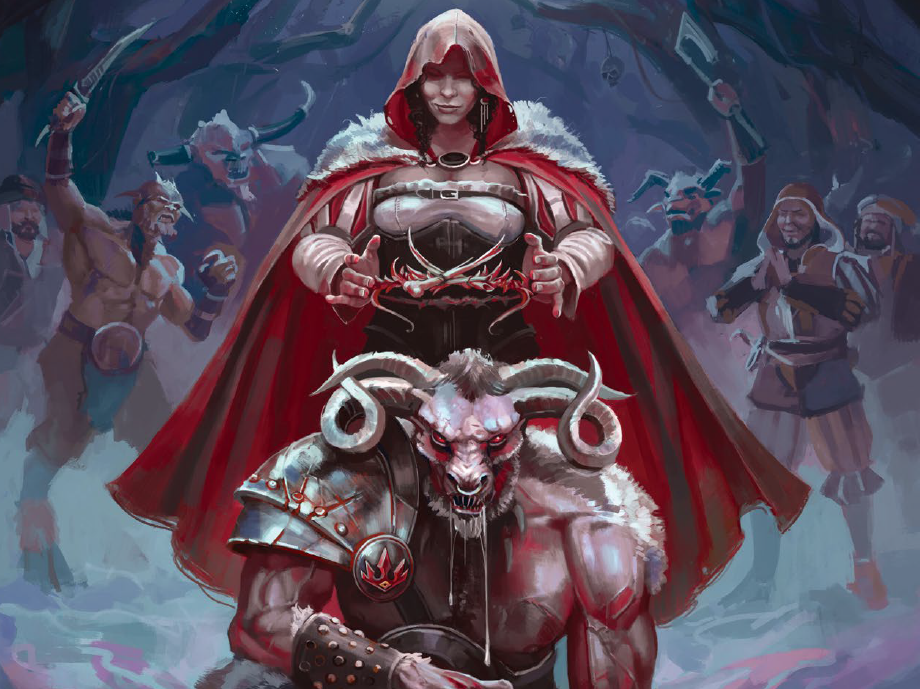
The other rather crucial omission is that I can’t see anything to give a timescale for the PCs journey! How fast does their barge move? (It’s probably in the DotR Companion, but it should be here.) And even if we knew, it wouldn’t be that much help, because the map provided with the adventure doesn’t feature a scale! We simply don’t know how it is between, say, Altdorf and Grissenwald – is it 200 miles? 500? It’s an absolutely gorgeous map – the same one, of the “Glorious Reikland” as in the core rulebook – but it is far less usable than the one in the original adventure. (That one was a hex map which clearly showed distances; this one not only lacks a scale, but – at least at the resolution supplied in my pdf copy – doesn’t allow you to zoom in enough to determine basic details like which side of the river Castle Wittgenstein sits on.)
I should also mention the Red Crown here. Etelka Herzen is a decent character – memorable since she uses an excessive amount of perfume to cover up the foul odour that results from her Chaos corruption. Unfortunately insufficient motivation is given to her and her cultist companion Ernst, the main antagonists of the first half of the adventure. The plans of the Red Crown are revealed in only the most vague of details; their goal is to find the warpstone, but what exactly are they going to do with it? It would also be helpful to have more guidance for roleplaying the pair, and it is disappointing that no suggestions are given for tactics that they might use in the eventual fight, which would be really useful given the variety of spells and items at their disposal. (As a more minor quibble, it is also odd that the XP reward for defeating Etelka is found at the end of the Grissenwald chapter, where the PCs are very unlikely to encounter her, rather than in the same chapter as her profile. Confusing and likely to catch out a GM who doesn’t have a very thorough knowledge of the material.)
On Down the River
In any case, whether they investigate the signal tower or not, the PCs will carry on down the Reik. A few major landmarks en route are detailed, though sadly plenty of settlements along this stretch of the Reik are completely ignored. The main stopping points are Kemperbad – a major town en route – and Grissenwald, which is the PCs’ initial destination given that it the given address of Etelka Herzen. Kemperbad gets about a page of information, sadly without a map, while Grissenwald gets a little more (and does get a map, I’m happy to say). In both locations there are a wonderful selection of rumours, which make the world feel more alive, and there are scripted encounters with the Purple Hand.
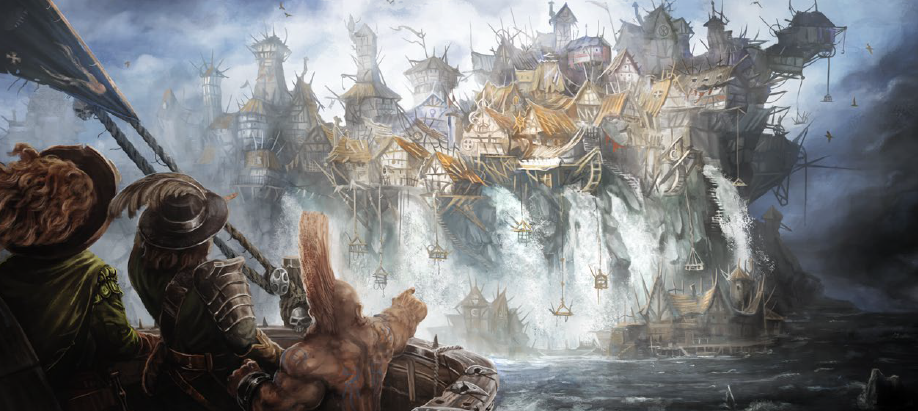
These have always been one of the most memorable elements of Death on the Reik, as the PCs are the target of increasingly bizarre behaviour from cultists trying to pass on secret signs which the PCs have no knowledge of. There’s a lot of comedy to be mined from these encounters, along with the obvious mystery of who these weird people are.
One thing to mention here is that there is still the problem that nosy PCs may try to investigate Castle Wittgenstein too early – this is supposed to be the subject of the second half of the adventure, but they’re bound to pass it, it’s a big spooky castle with a dreadful reputation, and it is after all on the cover of the original book (and the Death on the Reik Companion). This book suggests two options to head this off. One is extreme (move the castle somewhere else!), the other unconvincing (they can’t find the way in). An obvious alternative would be that the PC simply don’t have a chance of getting into the castle without the information from the outlaws – who are currently nowhere to be found.

Grissenwald itself see the PCs dealing with the Dwarfs of Khazid Slumbol, who are now dwelling in a slum outside the town, having been displaced from their mine by Etelka Herzen. I’m pleased to see that they get a bit more detail than in the original adventure, but the town is still rather under-developed; it would have been nice at least to get the name of an inn, and perhaps those of the town’s chief movers and shakers. The PCs may or may not deal with the Dwarfs but regardless, they’ll end up clashing with the Goblins that Etelka has left behind at her tower, before being pointed to her destination in the Barren Hills – where the warpstone meteorite landed 200 years ago. (One of the more amusing elements is that the Goblin leader has decided that wearing Etelka’s clothes will turn him into a powerful sorcerer.)
To the Barren Hills
This section of the journey sees the PCs retrace their route north on the Reik to Kemperbad, before striking off east down the Stir, and a tributary to the Barren Hills. There’s material here is relatively sparse, with brief detail on the village of Unterbaum and the Inn of the Roaring Falls (both at the point where the PCs need to head north off the River Stir); here the PCs will more-or-less unavoidably gain the services of Corrobeth, the village Priest of Rhya. The adventure doesn’t really entertain the possibility that the PCs might refuse his help, or do something outrageous to upset him, since without his help they have no chance of finding their destination! This has always been one of the segments of Death on the Reik that I’m rather lukewarm on, and the update hasn’t really improved things.
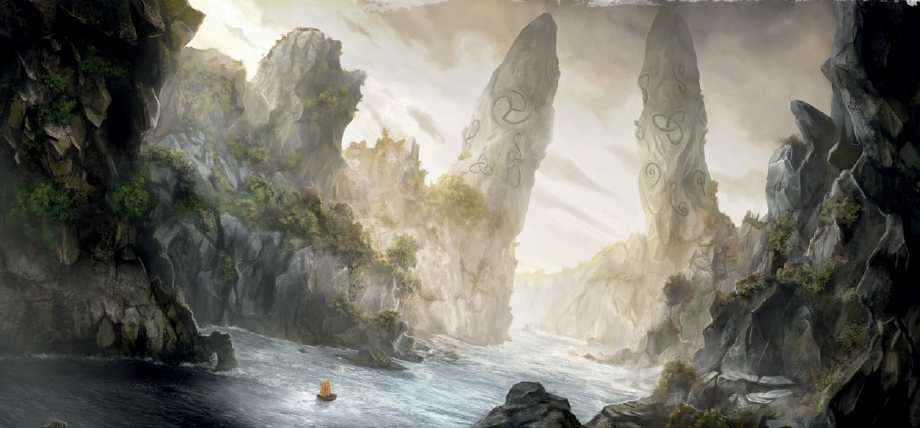
I do however like the weird terrain that the PCs encounter as they get closed to the site of the warpstone meteorite’s impact. There’s even a suggestion that the GM could use Chaos Terrain from Fire in the Mountains (the first part of the 1st Edition Doomstones campaign), which is not something I expected!
The Barren Hills introduces Skaven into the mix – as usual (for 1st Edition adventures at least) they’re hunting warpstone. This is also the site of a potential encounter with the Red Crown, if the PCs have made good time (see above). In any case, here the PCs will find the key they need to gain access to the inner rooms of the laboratory at the signal tower. This is ensured by the presence of a helpful ghost who will point it out and say (in effect) “don’t forget the plot coupon” – but I can’t be too critical of this, since I like the fact that the ghost also provides the opportunity to deliver a bit of backstory on the wizard-noble Dagmar von Wittgenstein (being a member of his expedition here to find the warpstone meteorite 200 years ago).
With the key in hand, the PCs can now return to the Laboratory/Signal Tower, penetrate the inner sanctum, and be pointed to Castle Wittgenstein for the marvellous second act of the adventure. Unlike the original adventure – which left the GM to basically piece together what happened here – there’s an entire (short) chapter covering the journey back through Kemperbad (including another Purple Hand encounter) to the tower, and giving some ideas for how events might unfold when the PCs arrive, depending on their actions earlier in the adventure and how close they are to the Red Crown. Then we go to the horrors of Castle Wittgenstein…
But let’s save that for Part 2 of the review.
Buy Death on the Reik from DriveThruRPG here or from Cubicle 7’s site here. The former is an affiliate link so I receive a small payment for purchases made using it.
Addendum: If you’re thinking of running Death on the Reik, be sure to check out Gideon’s ‘The Enemy Within: A Companion’, which addresses many of the issues with the adventure.
- Thanks to Theo Axner who correctly pointed out (in the comments below) that I was incorrect in initially crediting the original adventure to Graeme Davis as well as Phil and Jim. ↩︎
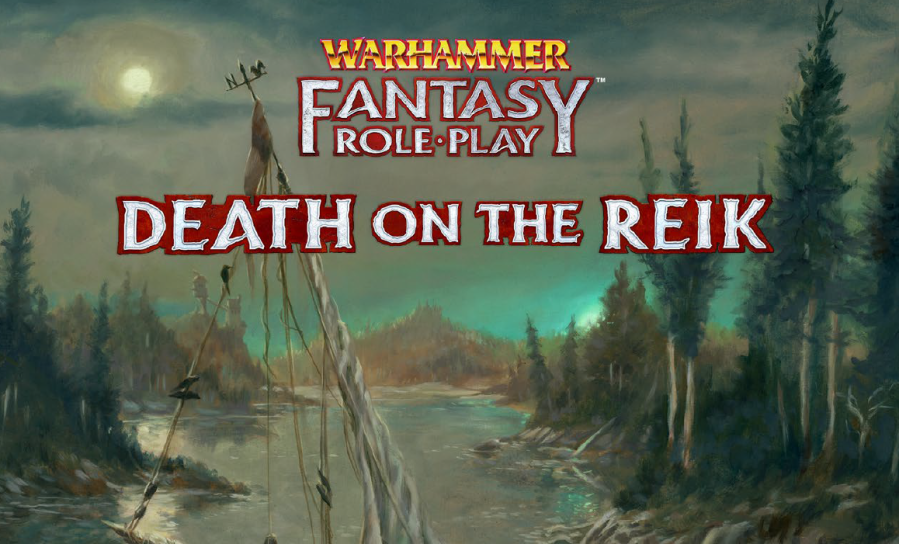
A simpler fix to the problem of visiting Castle Wittgenstein too early is to relocate Etelka Herzen’s home and the associated adventure episodes to Kemperbad.
LikeLiked by 2 people
That’s a good idea.
Your comment has reminded me I need to add a link to your Enemy Within companion to this review!
LikeLike
Good review. I really like the signal tower especially as it reinforces the setting, but do not like having to make the players return following the railroaded ghost encounter. I am sure there is a work around!
LikeLiked by 1 person
I’m sure there is – you could even have them find that Dagmar has set up a second laboratory at the meteorite site in the Barren Hills, which then directs them to the castle.
Personally I quite like the way the adventure has the PCs returning to places (the signal tower, Kemperbad – even the castle potentially) since I think it makes it feel less linear. But it does risk clever players breaking the structure!
LikeLiked by 2 people
Good to see this. I’ll be saving most of what I might have to say for the second parts, when I’ve seen what you cover in that (I assume any discussion of the adventure text’s restructuring from a semi-sandbox format to a linear railroad will come then, for instance).
A couple of minor – perhaps nitpicky – points in the meantime:
“The original adventure was written by Jim Bambra, Graeme Davis, Phil Gallagher.“
I can’t quote chapter and verse right now, but I’m pretty sure the adventure itself was written by Bambra and Gallagher, while Davis wrote the ‘River Life of the Empire’ booklet.
“The new version provides a very welcome timeline for the Red Crown’s expedition, and lots of options for where they might encounter the PCs.”
The timeline was in the original as well (p. 21). In the new version, as you point out, it’s rendered entirely meaningless (as is the map, pretty as it is) by the lack of a scale. This is particularly striking since some early 4E maps – including IIRC the one in Enemy in Shadows – had shown a greatly inflated scale to most earlier maps, making distances at least 1/3 longer. However, the text includes at least one reference to distances on p. 27: “The adventurers’ journey from [sic] Grissenwald and Black Peaks takes them up almost 270 miles of the River Reik.” This is ambiguous since it doesn’t specify where the end points are, but it’s apparently a garbled cut-and-paste of a passage from the original (p. 22): “The adventurers’ journey from Delberz to [emphasis mine] Grissenwald and Black Peaks takes them up almost 270 miles of the River Reik.” This implies that the new DotR uses the same scale as the old maps, rather than the inflated scale of early 4E maps.
Presumably this is resolved one way or the other in the VTT version, but I’m not familiar with that.
Generally speaking (I suppose we’ll talk more about this in part 2) this is where Andy Law jumped ship, and the effect is noticeable to say the least. As you note there’s very little of the added detail we got in Enemy in Shadows, and virtually none of the new elements introduced or foreshadowed in Shadows – such as the weird goings-on in Altdorf, or the possible links to the Ubersreik situation – get any development or even acknowledgement here.
LikeLiked by 1 person
Thanks – yes I’m sure you’re correct about the authorship of the original, and I’ve corrected the post (and credited you).
You’re also quite right that the original included a timeline for the Red Crown – what the new version adds is suggestions for where the PCs might cross paths with the cultists. (Which I think is helpful.) Good spot about the typo on the journey distance, I’d missed that.
I hadn’t realised this was where Andy Law parted ways with Cubicle 7 – I wasn’t following WFRP 4e developments so closely at the time. (I’m still hopeful the story of that might come out one day – although there’s a little hint in a recent tweet he made.)
LikeLiked by 2 people
It’s only fair to acknowledge that the new version does have some notes on staging the showdown with Etelka’s crew, something that was sorely lacking in the original. 🙂
LikeLiked by 1 person
Pingback: Review: Death on the Reik (part 2) – Ill Met by Morrslieb
I’ve just finished running the whole of Death on the Reik. This part of the thing feels quite mediocre, definitely not up to the reputation of one of the greatest adventures of all time. I feel like this reputation comes from the eighties but isn’t really true any more.
(I should note that I never played or read first edition, so I came to this as a new player from different games, largely due to its underserved reputation of greatness.)
Anyway… the individual pieces here were good or even great. The places, the characters, the situations. Some great ideas. However, the structure of the thing is just poor. First of all, I can’t say I agree with the assessment that it gives the players an „unprecedented amount of freedom“ – where, exactly, is the freedom evident? This half of the adventure is a blatant railroad: you go from point A to point B to point C to point D and you can’t do anything about it.
Some points are more open (Etelka’s home at least allows you to approach the situation from different angles and attempt different solutions), but that’s not always the case. How many “different playthroughs” are possible in the signal tower? Or in the Barren Hills? None really – this is heavily scripted with barely and freedom at all.
The fact that that are hundreds of miles of space between the stops of the railroad doesn’t constitute freedom – not when there’s “nothing in them”, no descriptions, nothing gameable. As far as the adventure is concerned, they don’t exist.
I think I can stomach linearity, or even a railroad, if the experience and the story is great. Which it isn’t in this case – it’s horrible. Me and by players often got frustrated. The lack of any credible motivation for the characters is critical. I can’t even tell how many times my players said something like “I guess we have no reason to continue with this, right?” And I had to admit: “I know, but please do, we all want to play this through.” That’s not a good motivation for an enjoyable campaign.
It’s annoying that the “story” not only doesn’t bother to give you any motivation but it also actively negates anything you may want to know. It never gives you any answers. The signal tower? It feels pointless for the first time. The Purple Hand is just annoying because no matter what you do, the players won’t find out anything (and my players did – they captured them, and interrogated them, tried to lose their track – it’s all pointless, and I as a GM have nothing to work with – very frustrating for all of thus). Then the plot with the Purple Hand gets abandoned completely, with no explanation and no satisfactory ending. Then there’s the Red Crown, oh my! Then you kill Etelka (but why?) and the Red Crown gets abandoned again – no explanation, no closer, no feeling of achievement. What was the Red Crown anyway? I don’t know, please don’t ask me… I guess you now have to go and find some warpsone.
“Wait, why should we – fairly normal people – care about some warpstone in a scary castle?”
“I don’t know, I know it doesn’t make sense, just please do that.”
Nothing really makes sense, there’s no story, just disparate elements which get abandoned willy-nilly.
Oh and the travel times! I actually ran the numbers. If you figure out the at the distance using other maps which have a scale, and attempt to use the official travel speeds from various 4e products, you find that they don’t agree. I had to find the travel times from 1e, and suddenly it makes sense – the adventure uses values from first edition, not from fourth (nobody bothered updating them and – obviously and scandalously – nobody bothered playtesting this). Even then it’s almost impossible for the players to keep up because even a single day of delay – or a single attempt of enjoying the “unparalled amount of freedom” will throw the timeline off.
I did enjoy playing this – of sorts – some of the characters and places are amazing. but it really was quite frustrating at times. I will have nicer things to say about Castle Wittgenstein but up until that point, Death on the Reik is a mediocre railroad and not “one of the greatest campaign of all time” as I was promised. (I’d rank Bögenhafen much higher.)
LikeLiked by 2 people
Sorry you were unimpressed by it! I think my “unprecedented amount of freedom” is hyperbole combined with nostalgia – these were some of the first adventures I ever GM’d (30 years ago!) and its hard to take off the rose-tinted spectacles sometimes! You are correct that the adventure is basically linear – its more the potential to be able to go anywhere (as opposed to being transported by NPCs as is generally in the first adventure).
I agree about the disappointing lacking of proper motivation for the PCs – as I note in Part 2 of my review – and this is definitely something the new version ought to have improved on. The whole (1st Edition) campaign suffers from this – a lot of the time it is expected that the PCs will investigate something because they are do-gooders who want to fight evil. (Which is rather at odds with the opening quote of the 4e rulebook!)
LikeLike
My rant may have come off worse than intended. I do think this is a good adventure… but I did get annoyed by the sloppiness of it, and I did expect the Director’s Cut to at least attempt to fix all of the issues that have been known for ages.
If this is the point where Andy Law left the project, I think that may explain why I have an overall better impression of Shadows over Bögehafen.
LikeLiked by 1 person
@markuscz: Agreed! It’s making me a bit nervous about how the new version of Power Behind the Throne (an adventure famously in need of improvement) is going to be!
LikeLike
Pingback: Idea: Death on the Reik as a sandbox adventure – Ill Met by Morrslieb
Pingback: A Brief Overview of the 4E The Enemy Within – The Enemy Within: Remixed